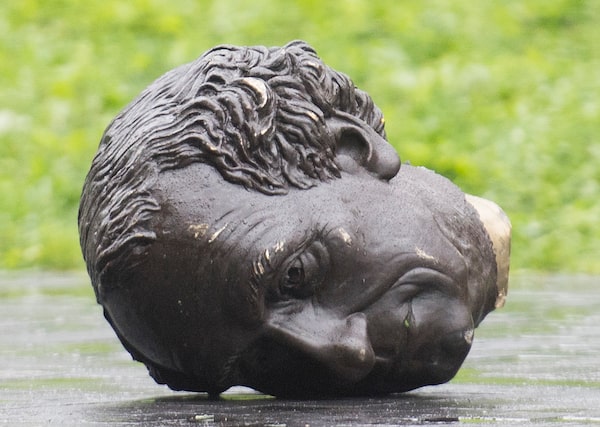
The head of a statue of Sir John A. MacDonald is shown torn down following a demonstration in Montreal, on Aug. 29, 2020.Graham Hughes/The Canadian Press
Taylor Noakes is an independent journalist and historian from Montreal.
Take it from a historian: If heads are going to roll, it’s preferable they be cast in bronze.
We tend to have inconsistent opinions regarding the toppling of monuments. When they’re brought down by mobs of jubilant Iraqis or Eastern Europeans, we celebrate the triumph of liberty and freedom of expression – our core democratic values. But when it happens here at home, it’s all anarchy and cancel culture.
If it rubs you the wrong way to know that people might compare aspects of such tyrants to Sir John A. Macdonald, whose statue was pulled down in Montreal by protesters this weekend, you’re likely not Indigenous. We tend to have a remarkable ability in this country to identify brutality abroad, but also to ignore it here at home in our own history.
Chalk it up to a maddeningly persistent national inferiority complex, but we often make false idols of our forebears. Statue fetishists insist that removing them erases history, and with this thinking, we’re left with a pedophile watching over tourists in Vancouver, a slave owner welcoming university students in Montreal and vast swaths of Kingston dedicated to the man chiefly responsible for our national shame.
If I had to hazard a guess, up until Saturday most Canadians likely had no idea that the largest and most elaborate monument to Macdonald is in, of all places, downtown Montreal. Fewer still know that the statue had been decapitated once before, in the wake of the stillborn Charlottetown Accord, and left headless for a couple years in the mid-1990s. It was more than a smidge ironic to now see Quebec nationalists of the hard and soft varieties jumping on the outrage bandwagon, demanding that order must be maintained.
Indeed, most of us likely don’t think twice about monuments until someone defaces them. Most Canadians were surely surprised to learn of a monument in Oakville, Ont., devoted to Nazi collaborators after it was vandalized in June – and shocked when Halton Police opened a since-suspended hate-crime investigation into the incident. Meanwhile, our leaders will appeal for calm and dialogue on matters of contested commemoration, but they will rarely admit that, left alone, monuments often say very little. Indeed, for the most part, monuments and memorials are little more than park decorations. Defenders of the status quo may swear that monuments are history incarnate, but without such instances of direct action and public participation, no conversation actually occurs.
It only took toppling a single statue and suddenly we’re all talking about Macdonald’s legacy. A blockbuster biopic wouldn’t generate half as much discussion. And it’s a discussion we desperately need to have. Macdonald played a central role in the dispossession, disenfranchisement and damn-near disappearance of the Indigenous of this land. Over a century-and-a-half later, we’re still coming to terms with the mess he created. Late biographer Richard Gwyn perhaps accidentally demonstrated the extent of Canadians’ aversion to historical complexity when he speciously stated “no Macdonald, no Canada,” as if such reductionism was wildly illuminating.
The nation has changed considerably since Confederation. Our monuments? Less so. A considerable bulk of our nation’s historic markers and monuments predate the Second World War and represent a particularly imperial interpretation of our history. Indeed, when the monument in question was unveiled in Montreal in 1895, Macdonald was lauded not so much for founding Canada but for his loyal service to the British Empire.
Meanwhile, the recently renovated city park in which the Macdonald monument sits contains no contemporary public art and says almost nothing about Canadian history. In doing so, however, Place du Canada unintentionally speaks volumes about the nation. It is a large open space, paved charcoal-grey and adorned with reminders of death, war and empire. Along the plaza’s edge are cannons from the Crimean War, the Macdonald monument, the city’s cenotaph, and an arbitrary howitzer, pointing at nothing in particular. Surrounded by old baggage, this great grey emptiness awaits a statement about who we truly are and what we hope to be.
We are long overdue for new commemoration. Statuary does little to inform; rather than illuminate, it tends to occlude historical reality by literally putting people on pedestals.
We have the means and the imagination to do much better. All that’s missing is the courage to step boldly forward, accepting that we come not from greatness, but aspire to it.
Keep your Opinions sharp and informed. Get the Opinion newsletter. Sign up today.